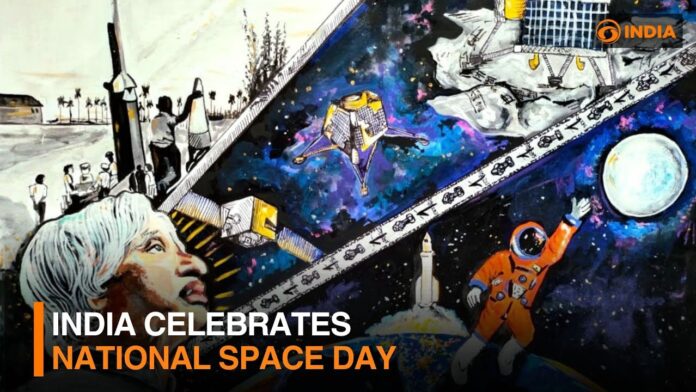August 23 is now National Space Day in India, commemorating the historic soft landing of Chandrayaan-3 on the Moon in 2023
India marks a new chapter in its space exploration history with the celebration of its first National Space Day on August 23, 2024. This day commemorates the landmark achievement of the Chandrayaan-3 mission, which successfully completed a soft landing on the Moon on the same date in 2023.
The Chandrayaan-3 mission, led by the Indian Space Research Organisation (ISRO), represented a significant leap in India’s space capabilities. The Vikram lander of the Chandrayaan-3 spacecraft made a historic landing near the lunar south pole, an area previously unexplored. This success followed the partial success of Chandrayaan-2 in 2019 and solidified India’s status as a major player in space exploration.
The first National Space Day celebration features the theme “Touching Lives While Touching the Moon: India’s Space Saga,” highlighting the impact of space missions on various aspects of life on Earth. The day is marked by events across the country, including exhibitions, lectures, and interactive sessions aimed at inspiring the next generation of scientists and engineers.
The soft landing of Chandrayaan-3 was a technical triumph that demonstrated ISRO’s advanced capabilities in space technology. The mission’s success has been widely celebrated as a symbol of India’s growing prowess in space exploration and its commitment to scientific advancement. It also reinforces India’s ability to contribute significantly to global space research and technology.
In addition to public celebrations, the government has planned a series of educational and outreach activities to engage students and the general public. These activities are intended to foster interest in science and technology and encourage more young people to pursue careers in these fields.
The Chandrayaan-3 mission’s successful landing has also had a substantial impact on India’s space program, boosting national pride and positioning India as a key player in the international space community. It serves as a reminder of the country’s growing influence and innovation in space exploration.
Analysis:
Political: National Space Day is not just a celebration of technological achievement but also a strategic move to bolster India’s position on the global stage. By commemorating this milestone, India demonstrates its commitment to advancing science and technology, enhancing its geopolitical standing. The success of Chandrayaan-3 aligns with the Indian government’s broader ambitions to become a leading player in space exploration and technology, further strengthening its international relations through scientific diplomacy.
Social: The celebration of National Space Day reflects India’s increasing emphasis on science and technology in its national discourse. It highlights the role of space exploration in national pride and social identity. The mission’s success serves as a motivational tool for students and professionals, inspiring them to pursue careers in science and technology. The day also underscores the importance of space missions in advancing societal knowledge and improving everyday life through technological innovations.
Racial: The celebration of National Space Day and the success of Chandrayaan-3 emphasize the progress of a diverse and inclusive workforce in India’s space program. It highlights the contributions of scientists and engineers from various backgrounds, promoting the idea that space exploration is a collaborative effort that transcends racial and ethnic boundaries. The mission showcases India’s commitment to leveraging the talents and skills of its diverse population in achieving global scientific milestones.
Gender: National Space Day also provides an opportunity to address gender diversity in STEM (Science, Technology, Engineering, and Mathematics) fields. The success of Chandrayaan-3 includes contributions from women scientists and engineers, showcasing their critical role in space exploration. Celebrating this achievement encourages greater gender inclusivity and serves as a platform to promote equal opportunities for women in scientific and technological careers.
Economic: The achievement of Chandrayaan-3 has potential economic implications for India. It enhances the country’s reputation as a reliable partner in space missions, which could attract international collaborations and investments. The success of the mission also fosters the growth of the domestic space industry, potentially leading to new business opportunities and advancements in technology that can drive economic growth. Additionally, the educational and outreach activities associated with National Space Day may stimulate interest in STEM fields, contributing to a more skilled workforce that can support future economic development.
